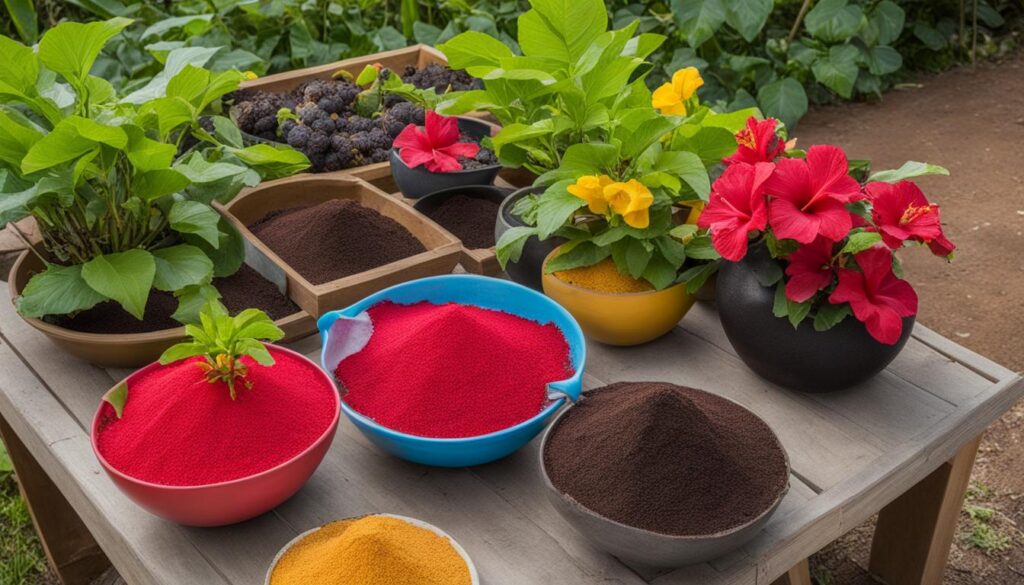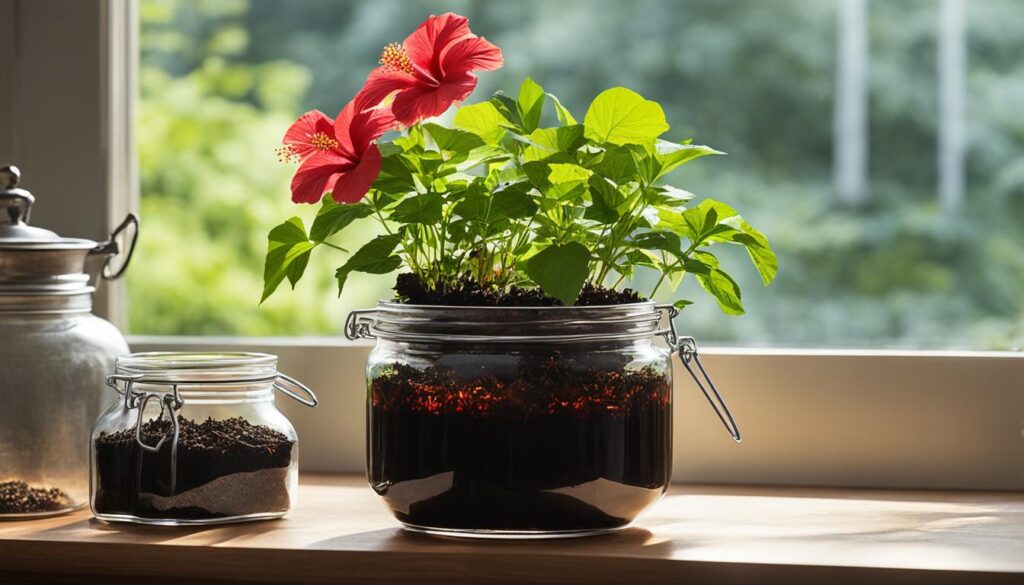As a hobby farmer and tropical hibiscus enthusiast, I’ve discovered that the secret to nurturing vibrant hibiscus blooms lies in understanding natural plant nutrition. Crafting homemade fertilizers for hibiscus is not just about saving on costs; it’s about customizing a nourishing diet for these flamboyant flowers. My exploration into organic fertilization has led me to value the beauty of simplicity and effectiveness that household items can bring in bolstering hibiscus care.
Going beyond store-bought solutions, I’ve learned that items like banana peels and diluted vinegar can act as a powerhouse for providing essential nutrients. By integrating basic yet potent elements into their diets, we can encourage our hibiscus to flourish with vigorous growth and an impressive bloom showcase. Join me as we delve into the realms of homemade concoctions and witness our hibiscus gardens thrive.
Key Takeaways
- Homemade fertilizers can effectively meet the hibiscus plant’s nutritional needs.
- Using natural items like banana peels and vinegar ensures vibrant hibiscus blooms.
- Customized plant nutrition boosts overall hibiscus care and growth.
- Simple household items can serve as powerful organic fertilizers.
- Tailored feeding regimes promote lush foliage and stunning flowers in hibiscus plants.
Understanding the Nutritional Needs of Hibiscus Plants
As a devoted hobby farmer, I’ve always marveled at the way hibiscus flowers add a splash of color to our tropical landscape. But achieving those vivid blooms is anything but accidental—it’s about understanding and meeting the precise hibiscus nutritional needs. Let’s delve into the key elements that make for a flourishing hibiscus plant.
The Importance of Nitrogen Balance
Maintaining the right nitrogen balance is akin to walking a tightrope; it can tip easily towards either excess or deficiency. Too much, and your hibiscus will boast of lush leaves at the expense of blooms. Too little, and the growth is stunted, leaving the plant vulnerable. From my experience, a moderated approach works best—giving just enough to sustain a healthy growth without overshadowing the potential for blooms.
Phosphorus: A Double-Edged Sword for Hibiscus Health
When it comes to phosphorus for plants, it’s a double-edged sword especially for our tropical star, the hibiscus. While essential for energy transfer and photosynthesis, an imbalance can disrupt the nutrient uptake, locking out vital nourishment. Thus, I’ve found that a gentle hand is essential when applying phosphorus-based amendments to the soil.
Why Potassium is Crucial for Vibrant Hibiscus Blooms
The potassium benefits in hibiscus cannot be overstated. It plays a pivotal role in water regulation and transporting nutrients within the plant, contributing to those stunning, healthy blooms we all adore. A higher dose of potassium, relative to other nutrients, assures me that my hibiscus plants remain hydrated, vibrant, and full of life.
Organic Solutions: Vinegar and Acidic Additives
As a gardener deeply engrossed in hibiscus care, I’ve delved into the realm of organic hibiscus fertilizer, tapping into the potential of household items such as vinegar to nurture these tropical beauties. It’s fascinating how a simple pantry staple can have such a profound effect on plant growth when used correctly.
Allow me to share a practical tip: a diluted solution of vinegar for plants – specifically for our hibiscus friends – can aid in unlocking and distributing essential nutrients in the soil. However, a word of caution: it’s imperative to avoid any direct application on leaves and delicate blooms to prevent damage.
Using vinegar is like conducting a gentle symphony in the soil, harmonizing nutrient availability with the perfect acid levels that hibiscus plants yearn for.
In addition to vinegar, certain acidic soil amendments for hibiscus play an integral role in soil health. My experience has shown that incorporating organic matter like spent tea grounds, which are laced with beneficial tannic acids, can substantially enrich the soil.
- Tannic acids from tea grounds foster a more fertile environment.
- Organic additions foster beneficial microbial activity.
- Amendments like these improve overall soil structure.
| Amendment Type | Benefits for Hibiscus | Application Notes |
|---|---|---|
| Diluted Vinegar Solution | Nutrient release and pH adjustment | Apply to the soil, avoid foliage |
| Tea Grounds | Enriching soil with tannic acids | Mix into the soil or compost |
What Are the Best Homemade Fertilizer for Hibiscus
As I delve into the garden, I’ve uncovered that the best homemade fertilizer for hibiscus plants often comes straight from our kitchen and yard waste. Crafting a nutrient-rich mix doesn’t have to be complicated or expensive – typical household items harbor surprising amounts of the essential elements needed for healthy, blooming hibiscuses.

Coffee Grounds and Their Surprising Nutrients
My morning ritual now serves a dual purpose; coffee grounds for hibiscus plants have proven to be an incredible resource. These leftover granules are rich in nitrogen, an essential component that promotes lush green foliage and robust growth. The acidity of the coffee also helps to maintain the pH levels in the soil that hibiscuses love.
Utilizing Bananas and Their Peels
Another surprising hero for plant nutrition is the banana peel. As a plant fertilizer, banana peels slowly release potassium and additionally provide a healthy dose of phosphorus and calcium, all of which are important for the proper development of hibiscus flowers.
Wood Ash: A Potassium Powerhouse
The fireplace ashes that were once thought of as waste can now become an important asset. Wood ash for potassium in the garden boosts the mineral content of the soil, offering a substantial supply to support the vibrant blooms of the hibiscus. A sprinkle of ash in the compost pile or directly around the base of the plants can greatly improve their potassium intake.
| Fertilizer | Nitrogen | Phosphorus | Potassium |
|---|---|---|---|
| Coffee Grounds | High | Medium | Low |
| Banana Peels | Medium | Low | High |
| Wood Ash | Low | Low | Very High |
Liquid Fertilizers: From Compost Tea to Fish Tank Water
As I delve into the realm of liquid fertilizers for hibiscus care, I’ve come to appreciate the simplicity and effectiveness of homemade options. These nourishing fluids offer a direct route of nutrients to our beloved blooms, ensuring they receive the best care from natural sources.
Preparation and Use of Compost Tea
My garden routine includes the craft of brewing compost tea, which is known for its impressive compost tea benefits. This liquid fertilizer is created by allowing fully decomposed compost to steep in water, essentially creating a ‘tea’ rich in beneficial microorganisms and nutrients. Once strained, I dilute the tea with more water until it’s the color of weak tea—perfect for delivering a gentle yet potent boost of nutrients to the hibiscus roots.

The Benefits of Aquarium Water for Hibiscus
Aquarium owners will be thrilled to know that when they change their tank water, they’re in possession of a fantastic liquid fertilizer. Aquarium water for plants, and specifically hibiscus, is like liquid gold. It’s rich not only in nitrogen but also in other micronutrients released into the water by fish and aquatic flora. This reuse of waste water is a prime example of eco-friendly plant care that supports a more sustainable approach to gardening.
Seaweed’s Role in Hibiscus Nutrition
When it comes to seaweed fertilizer for hibiscus, its value cannot be overstated. Seaweed extracts are burgeoning with plant hormones and trace elements essential for robust plant growth. It’s particularly effective in bolstering the plant’s resistance to stress, pests, and diseases. The commercial seaweed fertilizers available are a convenient option, but you can also make your own by steeping dried seaweed in water, much like making tea.
In my experience, these liquid options not only feed the plant but also improve the soil quality, enriching my garden ecosystem. Here’s a table that outlines the nutrient contributions of each of these liquid fertilizers:
| Fertilizer Type | Nutrients Provided | Frequency of Use |
|---|---|---|
| Compost Tea | Nitrogen, Phosphorus, Potassium, Microorganisms | Every 4-6 weeks |
| Aquarium Water | Nitrogen, Micronutrients | With every water change (typically bi-weekly) |
| Seaweed Extract | Plant Hormones, Trace Elements | Every 2 weeks during growing season |
Nurturing Hibiscus with Animal-Based and Mineral Fertilizers
When I delve into the realm of hibiscus care, I make it a point to incorporate a mix of animal-based and mineral fertilizers, understanding that these supplements are fundamental for those enchanting blooms. My approach involves integrating worm castings within the soil, a prime source of potassium, phosphorus, and nitrogen. These are the architects of vibrant growth, directly feeding into the plant’s powerhouse to produce those iconic, large flowers.
My regimen doesn’t stop there – I’m vigilant about the incredible impact blood meal and bone meal for hibiscus have on their growth. Subtle in their approach, they strengthen the soil and aid in fostering a vibrant ecosystem below the surface. The nutrient-rich profile of these fertilizers correlates with lush foliage and an increased resilience of my hibiscus to common pests and diseases. Using animal manures, particularly those from cows and chickens, offers yet another layer of natural nutrition. These manures act as a slow-release fertilizer, ensuring my hibiscus have access to the organic matter they need over time.
Moreover, the benefits of Epsom salt for plant growth can’t be overstated. Mixed into a fine powder with banana peels and crushed eggshells, this blend not only provides a requisite dose of magnesium but also enhances chlorophyll production. This contributes to deeper green leaves and a robust structure, allowing my hibiscus to stand tall and display its flowers with pride. Through the use of these mineral supplements for plants, I’ve witnessed a noticeable difference in bloom size and plant vibrance. Mindful usage of these potent fertilizers is part of my strategy to welcome a season of abundant and lustrous hibiscus displays in my garden.

